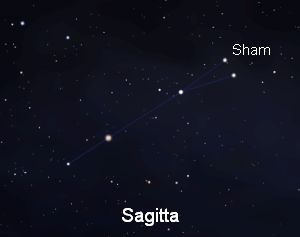¡SkyCaramba! Weekly astronomy blog for the week ending June 21, 2014
A nearly unnoticed arrow flies over our heads in June. Perhaps we would pay more attention to it if it were closer to Valentine’s Day. Then we may recognize it as Cupid’s arrow and look upon it wishing where it would fall. But in most stories, Sagitta is an arrow of death.
It’s also a little hard to see this arrow. Its stars are 3rd and 4thmagnitude and they form one of the smallest constellations. Certainly, ancient cultures saw it much more easily than we can in our light polluted skies. To

all of them, it looked like an arrow.
Sagitta has just one named Star. Sham is the Arabic word for arrow. Long ago, the constellation itself was sometimes called Sham or al-Sham. The star is about 620 light years away.
One popular ancient Greek story of Sagitta says it is the arrow Apollo shot at the Cyclopes. They had made the thunderbolts Zeus used to kill Apollo’s son.
Another legend says Heracles launched the arrow at Aquila which is a nearby constellation. Aquila is an eagle Zeus sent to torment Prometheus for stealing fire from Olympus.
Yet another tale says Heracles fired the arrow at the menacing Stymphalian birds. They had claws, wings, and beaks made of iron. And people were their favorite food!
And finally, let’s tell how Eros, usually known today by his Roman name Cupid, could inflict love spells by shooting people and other gods with arrows. In the old stories, love could cause as much grief as death, but somehow it’s still a more pleasant thing to think about.
Do not confuse Sagitta with Sagittarius the archer. He’s in a different part of the sky and has nothing to do with this arrow. Although it may seem like an obvious connection, none of the old stories link Sagitta to Sagittarius!
You can see Sagitta from almost anywhere in the world except where bright lights obscure dimmer stars. Look for it rising in the east after dark this time of year. You will see Cygnus the swan on the left and Aquila the eagle on the right. Above the arrow is Lyra the harp. Delphinus the dolphin is below it. You may even spot the wolf Vulpecula nearby, but it’s even harder to see.
¡SkyCaramba!
http://www.topastronomer.com/StarCharts/Constellations/Sagitta.php
http://www.constellation-guide.com/constellation-list/sagitta-constellation/
